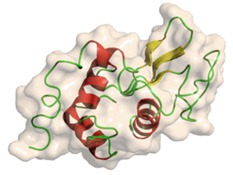BionatFP LZM95 (Lysozyme) :Natural Food Preservative
Seebio Natural Food Preservative: BionatFP LZM95 (Lysozyme)
|
Name: |
BionatFP LZM95 (Lysozyme) |
|
Alternative Names: |
Muramidase; N-acetylmuramide glycanhydrolase |
|
CASN |
9001-63-2; 12650-88-3 |
|
EINECS: |
235-747-3 |
|
EC: |
3.2.1.17 |
|
|

|
|
Use: |
The use of lysozyme in the food processing industry is connected primarily with its application as a natural preservative. The enzyme is widely used as a preservative for meat, fish and their products, for milk and dairy products, as well as for fruit and vegetables. |
|
Storage: |
2-8°C. |
Description:
Lysozymes, also known as muramidase or N-acetylmuramide glycanhydrolase, are glycoside hydrolases, enzymes (EC 3.2.1.17) that damage bacterial cell walls by catalyzing hydrolysis of 1,4-beta-linkages between N-acetylmuramic acid and N-acetyl-D-glucosamine residues in a peptidoglycan and between N-acetyl-D-glucosamine residues in chitodextrins.
Lysozyme is abundant in a number of secretions, such as tears, saliva, human milk, and mucus. It is also present in cytoplasmic granules of the polymorphonuclear neutrophils (PMN). Large amounts of lysozyme can be found in egg white. C-type lysozymes are closely related to alpha-lactalbumin in sequence and structure, making them part of the same family.
Function:
The enzyme functions by attacking peptidoglycans (found in the cell walls of bacteria, especially Gram-positive bacteria) and hydrolyzing the glycosidic bond that connects N-acetylmuramic acid with the fourth carbon atom of N-acetylglucosamine. It does this by binding to the peptidoglycan molecule in the binding site within the prominent cleft between its two domains. This causes the substrate molecule to adopt a strained conformation similar to that of the transition state. According to Phillips-Mechanism, the lysozyme binds to a hexasaccharide. The lysozyme then distorts the fourth sugar in hexasaccharide (the D ring) into a half-chair conformation. In this stressed state, the glycosidic bond is easily broken.
Application:
Lysozyme is used in "over-the-counter" drugs in order to increase the natural defenses of the body against bacterial infections. The pharmaceutical use of lysozyme encompasses applications such as oto-rhino-laryngology (lozenges for the treatment of sore throats and of canker sores), and in ophthalmology (eye drops and solutions for the decontamination of contact lenses).
Lysozyme is also added to infant formulae in order to make them more closely resemble human milk (cow's milk contains very low levels of a lysozyme enzyme).
Lysozyme is used as a preservative in food products. Several applications have been developed and patented, including the treatment of fresh fruits, vegetables, seafood, meat, tofu, sake and wine. However, the most important food application of lysozyme is, in the cheese industry. Lysozyme is used to prevent a problem known as "butyric late blowing", which occurs during the ripening of certain European-type cheeses. This problem is due to the contamination of milk by a naturally occurring, spore-forming bacterium, called Clostridium tyrobutyricum.
The research regarding the use of lysozyme in wine started in Europe in the early 1990s. The principle of using lysozyme in wine depends on the capability of this enzyme, thanks to its lytic action on gram positive bacteria, to control the growth of the lactic acid bacteria.Specification:
| Item |
Value |
|
|
powder |
liquid |
|
|
Total Dry Sub, w/% ≥ |
94 |
22 |
|
Water, w/% ≤ |
6 |
- |
|
Enzyme activity ≥ |
3.5×107FIP/g |
9×106FIP/ml |
|
Purity (on dry basis), w/% ≥ |
95 |
95 |
|
Ash, w/% ≤ |
1.5 |
0.3 |
|
N, w/% |
16.8-17.8 |
- |
|
Cl, w/% |
3.2-4.2 |
≤1.0 |
|
Na, w/% ≤ |
0.6 |
- |
|
pH (1.5% solution) |
3.0-3.6 |
3.0-4.0 |
|
Heavy Metal (Pb) /(mg/kg) ≤ |
10 |
10 |
|
Pb /(mg/kg) ≤ |
2 |
2 |
|
As /(mg/kg) ≤ |
1.0 |
1.0 |
|
Microbiological |
||
|
Item |
Value |
|
|
Aerobic plate count /(CFU/g) ≤ |
50 000 |
|
|
Moulds and yeasts /(CFU/g) ≤ |
100 |
|
|
E. coli, /1g ≤ |
Negative |
|
|
Salmonella, /25g ≤ |
Negative |
|
|
Staphylococcus aureus, /1g≤ |
Negative |
|
Order Information
| Catalog # |
Name |
Grade |
Pack Size |
Storage |
|
BionatFP LZM95 (Lysozyme) |
20000U/mg |
100mg |
2-8°C. Store in a well-closed container, away from direct sunlight and moisture. |
Seebio Natural Food Preservative: BionatFP BionatFP NS25 (Nisin)
Seebio Natural Food Preservative: BionatFP LZM95 (Lysozyme)
Seebio Natural Food Preservative: BionatFP PT90 (Natamycin)
Seebio Natural Food Preservative: BionatFP NA98 (Protamine)
Seebio Biotech(Shanghai) Co., Ltd.
11-502. Lane 299, Bisheng Rd.
Zhangjiang High Tech Park
Shanghai 201204, P.R.China
Tel: 86-21-50272975, 76, 77, 78, 79, 81; Ext:6513, 6515, 6516, 6520, 6521, 6522
For customers' complaint or suggestion: market5@seebio.cn
Web: www.seebio.cn
Email: fyland@seebio.cn; foodadd@seebio.cn
MSN:seebio8@hotmail.com
Skype:seebiocn
